|
11 -
The Essenes
The reader by now will be familiar with the conclusions of the
consensus view of the international team and, as expressed through
its journals, the Ecole Biblique, as well as with the processes by
which those conclusions were reached. It is now time to return to
the evidence and see whether any alternative conclusions are
possible. In order to do so, certain basic questions must again be
posed.
Who, precisely, were the elusive and mysterious denizens of
Qumran, who established their community, transcribed and deposited
their sacred texts, then apparently vanished from the stage of
history? Were they indeed Essenes? And if so, what exactly does that
term mean?
The traditional images of the Essenes come down to us from Pliny,
Philo and Josephus, who described them as a sect or sub-sect of lst-century
Judaism.1 Pliny, as we have seen, depicted the Essenes as celibate
hermits, residing, with 'only palm-trees for company', in an area
that might be construed as Qumran. Josephus, who is echoed by Philo,
elaborates on this portrait.
According to Josephus, the Essenes are
celibate - although, he adds, almost as an afterthought, 'there is a
second order of Essenes' who do marry.2 The Essenes despise pleasure
and wealth. They hold all possessions in common, and those who join
their ranks must renounce private property. They elect their own
leaders from amongst themselves. They are settled in every city of
Palestine, as well as in isolated communities, but, even in urban
surroundings, keep themselves apart.
Josephus portrays the Essenes as something akin to a monastic order
or an ancient mystery school. Postulants to their ranks are
subjected to a three-year period of probation, the equivalent of a
novitiate. Not until he has successfully undergone this
apprenticeship is the candidate officially accepted. Full-fledged
Essenes pray before dawn, then work for five hours, after which they
don a clean loincloth and bathe - a ritual of purification performed
daily.
Thus purified, they assemble in a special 'common' room and
partake of a simple communal meal. Contrary to later popular
misconceptions, Josephus does not describe the Essenes as
vegetarian. They are said to eat meat.
The Essenes, Josephus says, are well versed in the books of the Old
Testament and the teachings of the prophets. They are themselves
trained in the arts of divination, and can foretell the future by
studying sacred texts in conjunction with certain rites of
purification. In their doctrine, according to Josephus, the soul is
immortal but trapped in the prison of the mortal and corruptible
body. At death, the soul is set free and soars upwards, rejoicing.
Josephus compares Essene teaching to that of 'the Greeks'.
Elsewhere, he is more specific, likening it to the principles of the
Pythagorean schools.3
Josephus mentions Essene adherence to the Law of Moses:
'What they
reverence most after God is the Lawgiver, and blasphemy against him
is a capital offence.'4
On the whole, however, the Essenes are
portrayed as pacifist, and on good terms with established authority. Indeed, they are said to enjoy the special
favor of Herod, who
'continued to honor all the Essenes';5
'Herod had these Essenes in
such honor and thought higher of them than their mortal nature
required... '6
But at one point, Josephus contradicts himself -
or perhaps slips his guard.
The Essenes, he says:
despise danger and conquer pain by sheer will-power: death, if it
comes with honor, they value
more than life without end. Their spirit was tested to the utmost by
the war with the Romans, who
racked and twisted, burnt and broke them, subjecting them to every
torture yet invented in order to
make them blaspheme the Lawgiver or eat some forbidden food.7
In this one reference, at variance with everything else Josephus
says, his Essenes begin to sound suspiciously like the militant
defenders of Masada, the Zealots or Sicarii.
With the exception of this one reference, Josephus' account was to
shape popular images of the Essenes for most of the ensuing two
thousand years. And when the Aufklärung, the so-called
'Enlightenment', began to encourage 'free-thinking' examination of
Christian tradition, commentators began to make connections between
that tradition and Josephus' Essenes.
Thus, in 1770, no less a
personage than Frederick the Great wrote definitively that 'Jesus
was really an Essene; he was imbued with Essene ethics'.8 Such
apparently scandalous assertions proceeded to gain increasing
currency during the latter half of the next century, and in 1863
Renan published his famous Vie de Jesus, in which he suggested that
Christianity was 'an Essenism which has largely succeeded'.9
Towards the end of the 19th century, the revival of interest in
esoteric thought consolidated the association of Christianity with
the Essenes. Theosophy, through the teachings of H.P. Blavatsky,
postulated Jesus as a magus or adept who embodied elements of both
Essene and Gnostic tradition. One of Blavatsky's disciples, Anna
Kingsford, developed a concept of 'esoteric Christianity'.
This
roped in alchemy as well and portrayed Jesus as a Gnostic thaumaturge who, prior to his public mission, had lived and studied
with the Essenes. In 1889, such ideas were transplanted to the
Continent through a book called The Great Initiate, by the French
theosophist Edouard Schure. The mystique surrounding the Essenes had
by now begun to associate them with healing, to credit them with
special medical training and to represent them as a Judaic
equivalent of the Greek Therapeutae.
Another influential work,
The
Crucifixion by an Eye-Witness, which appeared in German towards the
end of the 19th century and in English around 1907, purported to be
a genuine ancient text composed by an Essene scribe. Jesus was
depicted as the son of Mary and an unnamed Essene teacher, whose
fund of secret Essene medical knowledge enabled him not just to
survive the Crucifixion, but also to appear to his disciples
afterwards as if 'risen from the dead'.
George Moore undoubtedly
drew on this work when, in 1916, he published The Brook Kerith and
scandalized Christian readers across the English-speaking world.
Moore, too, portrayed Jesus as a protégé of Essene thought, who
survives the Crucifixion and retires to an Essene community in the
general vicinity of Qumran. Here, years later, he is visited by a
fanatic named Paul, who, quite unknowingly, has come to promulgate a
bizarre mythologized account of his career and, in the process,
promote him to godhood.
The Essenes depicted in The Brook Kerith derive ultimately from the
'stereotyped' Essenes of Pliny, Josephus and Philo, imbued now with
a mystical character which endeared them to esoteric-oriented
writers of the late 19th and early 20th centuries. To the extent
that educated readers knew anything of the Essenes at all, this was
the prevailing image of them. And something of this image was
retained even by more critical commentators, such as Robert Graves,
who in other respects sought to demystify Christian origins.
When the Dead Sea Scrolls came to light, they seemed, on the surface
at least, not to contain anything that conflicted with the
prevailing image of the Essenes. It was only natural, therefore,
that they should be associated with the established conceptions.
As early as 1947, when he first saw the Qumran texts, Professor
Sukenik had suggested an Essene character for their authorship.
Father de Vaux and his team also invoked the traditional image of
the Essenes. As we have noted, de Vaux was quick to identify Qumran
with the Essene settlement mentioned by Pliny. 'The community at
Qumran', Professor Cross concurred, 'was an Essene settlement.'10 It
soon became regarded as an established and accepted fact that the
Dead Sea Scrolls were essentially Essene in their authorship, and
that the Essenes were of the familiar kind - pacifist, ascetic,
celibate, divorced from public and particularly political issues.
The community at Qumran, the consensus view contends, built upon the
much earlier remains of an abandoned Israelite fortress dating from
the 6th century BC. The authors of the scrolls arrived at the site
some time around 134 BC, and the major buildings were erected around
100 BC and thereafter - a chronology safely and uncontroversially
pre-Christian.
The community was said to have thrived until it was
decimated by an earthquake, followed by a fire, in 31 BC. During the
reign of Herod the Great (37-4 BC), Qumran was abandoned and
deserted, and then, in the reign of Herod's successor, the ruins
were reoccupied and rebuilding undertaken. According to the
consensus, Qumran then flourished as a quietist, politically neutral
and disengaged enclave until it was destroyed by the Romans in AD
68, during the war that also involved the sack of Jerusalem.
After
this the site was occupied by a Roman military garrison until the
end of the 1st century. When Palestine rose in revolt again between AD 132 and 135, Qumran was inhabited by rebel 'squatters'.11 It was
a neat, conveniently formulated scenario which effectively defused
the Dead Sea Scrolls of whatever explosive potential they might
have. But the evidence seems to have been ignored when expediency
and the stability of Christian theology so dictated.
There is a contradiction, quite apart from the geographical
question, in de Vaux's assertion that the passage from Pliny, quoted
here on page 20, refers to Qumran - a contradiction which pertains
to the dating of the scrolls. Pliny is referring, in this passage,
to the situation after the destruction of Jerusalem. The passage
itself indicates that Engedi has likewise been destroyed - which it
was.
The Essene community, however, is described as still intact,
and even taking in a 'throng of refugees'. Yet even de Vaux
acknowledged that Qumran, like Jerusalem and Engedi, was destroyed
during the revolt of AD 66-73. It would thus seem even more unlikely
that Pliny's Essene community is in fact Qumran. What is more,
Pliny's community, as he describes it, contains no women, yet there
are women's graves among those at Qumran. It is still, of course,
possible that the occupants of Qumran were Essenes, if not of
Pliny's community, then of some other.
If so, however, the Dead Sea
Scrolls will themselves reveal how ill informed about the Essenes
Pliny was.
The term 'Essene' is Greek. It occurs only in classical writers
- Josephus, Philo and Pliny - and is written in Greek as 'Essenoi' or
'Essaioi'. Thus, if the inhabitants of Qumran were indeed Essenes,
one would expect 'Essene' to be a Greek translation or
transliteration of some original Hebrew or Aramaic word, by which
the Qumran community referred to themselves.
Accounts of the Essenes by classical writers are not consistent with
the life or thought of the community as revealed by either the
external evidence of archaeology or the internal evidence of the
texts themselves. Josephus, Philo and Pliny offer portraits of the
Essenes which are often utterly irreconcilable with the testimony of
Qumran's ruins and of the Dead Sea Scrolls. The evidence at Qumran,
both internal and external, repeatedly contradicts their accounts.
Some of these contradictions have been cited before, but it is worth
reviewing the most important of them.
-
Josephus acknowledges that there is 'another order' of Essenes
who do marry, but this, he
indicates, is atypical.12 In general, Josephus says, echoing Philo
and Pliny, the Essenes are
celibate. Yet the graves of women and children have been found among
those excavated at
Qumran. And the 'Community Rule' contains regulations governing
marriage and the raising of
children.
-
None of the classical writers ever mentions anything to suggest
that the Essenes used a special
form of calendar. The Qumran community, however, did - a unique,
solar-based calendar,
rather than the conventional Judaic calendar, which is lunar-based.
If the Qumran community
were indeed Essenes, surely so strikingly noticeable a
characteristic would have been accorded
some reference.
-
According to Philo, the Essenes differed from other forms of
ancient Judaism in having no cult
of animal sacrifices.13 Yet the 'Temple Scroll' issues precise
instructions for such sacrifices.
And the ruins of Qumran revealed animal bones carefully placed in
pots, or covered by pots,
and buried in the ground under a thin covering of earth.14 De Vaux
speculated that these bones
might be the remains of ritual meals. They might indeed. But they
might equally be the remains
of animal sacrifices, as stipulated by the 'Temple Scroll'.
-
The classical writers use the term 'Essene' to denote what they
describe as a major sub-division of Judaism, along with the Pharisees and Sadducees. Nowhere
in the Dead Sea Scrolls,
however, is the term 'Essene' found.
-
Josephus declares the Essenes to have been on congenial terms
with Herod the Great, who, he
says, 'had these Essenes in such honour and thought higher of them
than their mortal nature
required'.15 Yet the Qumran literature indicates a militant
hostility towards non-Judaic
authorities in general, and towards Herod and his dynasty in
particular. What is more, Qumran
appears to have been abandoned and uninhabited for some years
precisely because of
persecution by Herod.
-
According to classical writers, the Essenes were pacifist. Philo
specifically states that their
numbers included no makers of weapons or armour.16 Josephus
emphatically distinguishes
between the non-violent Essenes and the militantly messianic and
nationalistic Zealots. Yet the
ruins of Qumran include a defensive tower of a manifestly military
nature, and what 'can only
be described as a forge'.17
As for the Qumran literature, it is
often martial in the extreme, as
exemplified by such texts as the 'War Scroll'. Indeed, the bellicose
character of such texts
would seem to have less in common with what Josephus says of the
Essenes than with what he
and others say of the so-called Zealots - which is precisely what
Roth and Driver claimed the
Qumran community to be, thereby incurring the fury of de Vaux and
the international team.
The Qumran community wrote mostly not in Greek, but in Aramaic and
Hebrew. So far as Aramaic and Hebrew are concerned, no accepted
etymology for the origins of the term 'Essene' has hitherto been
found.
Even the classical writers were mystified by its derivation.
Philo, for example, suggested that, in his opinion, the name stemmed
from the Greek word for 'holy', 'oseeos', and that the Essenes were
therefore the 'Oseeotes', or 'Holy Ones'.18
One theory has enjoyed a certain qualified currency among certain
modern scholars, notably Geza Vermes of Oxford University. According
to Vermes, the term 'Essene' derives from the Aramaic word
'assayya', which means 'healers'.19 This has fostered an image in
some quarters of the Essenes as medical practitioners, a Judaic
equivalent of the Alexandrian ascetics known as the 'Therapeutae'.
But the word 'assayya' does not occur anywhere in the corpus of
Qumran literature; nor is there any reference to healing, to medical
activities or to therapeutic work. To derive 'Essene' from
'assayya'', therefore, remains purely speculative; and there would
be no reason to credit it at all unless there were no other options.
In fact, there is another option - not just a possibility, but a
probability. If the Qumran community never refer to themselves as
'Essenes' or 'assayya', they do employ a number of other Hebrew and
Aramaic terms. From these terms, it is clear that the community did
not have a single definitive name for themselves.
They did, however,
have a highly distinctive and unique concept of themselves, and this
concept is reflected by a variety of appellations and
designations.20 The concept rests ultimately on the all-important
'Covenant', which entailed a formal oath of obedience, totally and
eternally, to the Law of Moses. The authors of the Dead Sea Scrolls
would thus refer to themselves as, for example, 'the Keepers of the
Covenant'.
As synonyms for 'Covenant' and 'Law', they would often
use the same words that figure so prominently in Taoism - 'way',
'work' or 'works' ('ma'asim' in Hebrew). They would speak, for
instance, of 'the Perfect of the Way', or 'the Way of Perfect
Righteousness'21 - 'way' meaning 'the work of the Law', or 'the way
in which the Law functions', 'the way in which the Law works'.
Variations of these themes run all through the Dead Sea Scrolls to
denote the Qumran community and its members.
In the 'Habakkuk Commentary', Eisenman, continuing this line of
thought, found one particularly important such variation - the 'Osei
ha-Torah', which translates as the 'Doers of the Law'.22 This term
would appear to be the source of the word 'Essene', for the
collective form of 'Osei ha-Torah' is 'Osim', pronounced 'Oseem'.
The Qumran community would thus have constituted, collectively, 'the Osim'. They seem, in fact, to have been known as such. An early
Christian writer, Epiphanius, speaks of an allegedly 'heretical'
Judaic sect which once occupied an area around the Dead Sea. This
sect, he says, were called the 'Ossenes'.23
It is fairly safe to
conclude that the 'Essenes', the 'Ossenes' of Epiphanius and the
'Osim' of the Qumran community were one and the same.
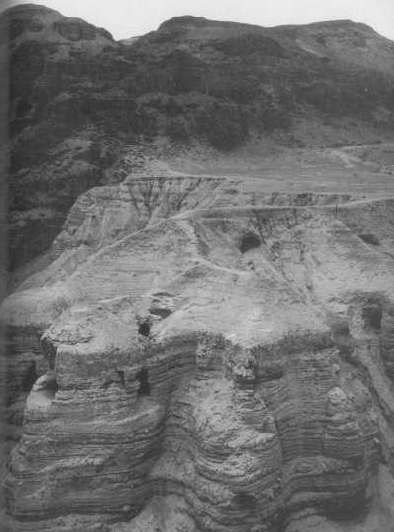
28 Qumran, showing the marl terraces. The photograph was taken from
the ruins looking west
towards the Judaean hills, with Cave 5 on the extreme left and the
two openings of Cave 4 just to the right.
The original entrance to Cave 4 can be seen above the right-hand
opening.
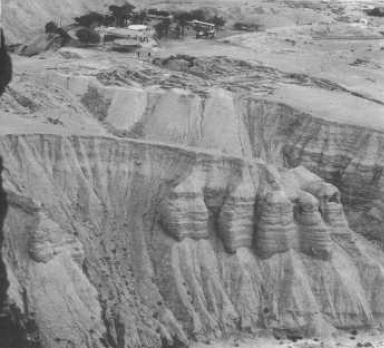
29 The ruins of Qumran. Caves 4 and 5 can be seen at the end of the
nearer eroded cliff-face.
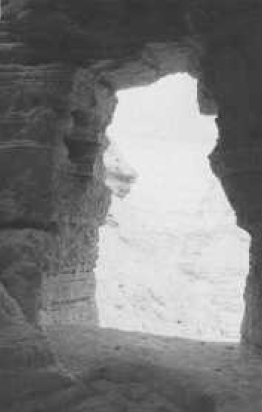
30 The interior of Cave 4, Qumran, where the largest number of
fragments
were discovered in 1952. Fragments of up to 800 different scrolls
were retrieved.
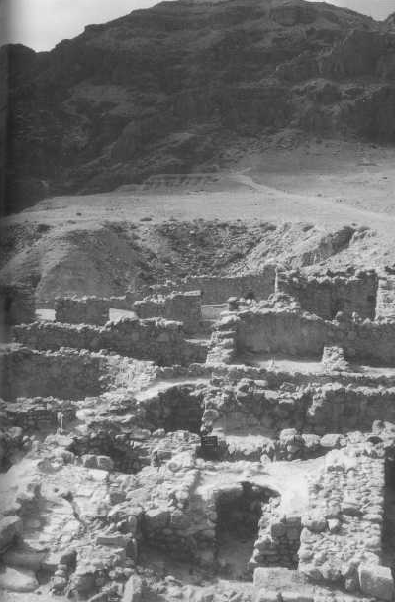
31 The Qumran ruins from the fortified tower. In the foreground are
the remains
of the circular weapons forge, to the left of which part of the
water conduit has been exposed.
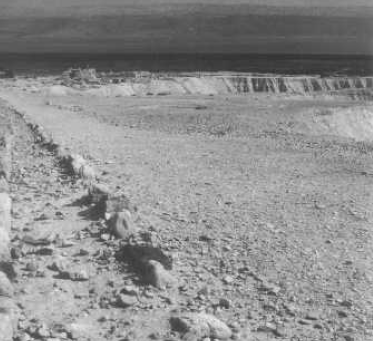
32 Remains of the main waterway into the Qumran community.
The site had a complex water system fed from
seasonal water flowing in the Wadi behind the ruins.
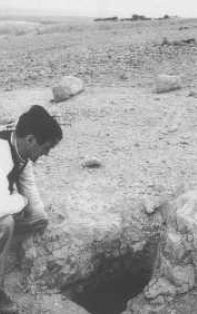
33 A cistern cut into the desert floor on the rocky terraces near to
the Qumran ruins.
Water control and storage were vital to the survival of such a
community.
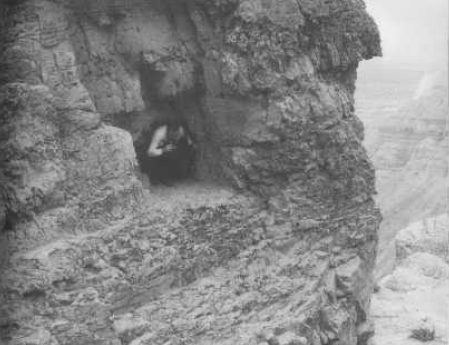
34 The water supply to Qumran depended upon this water tunnel carved
through solid rock
in the cliff-face. The water was dammed in the Wadi and directed
through this tunnel.
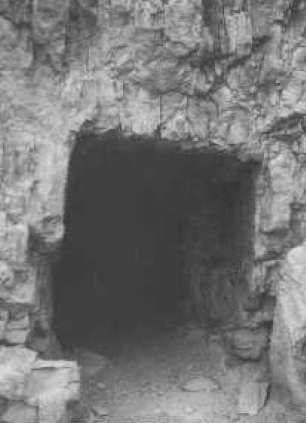
35 The exit of the water tunnel.
From here the water flowed down the Waterway to the settlement
itself.
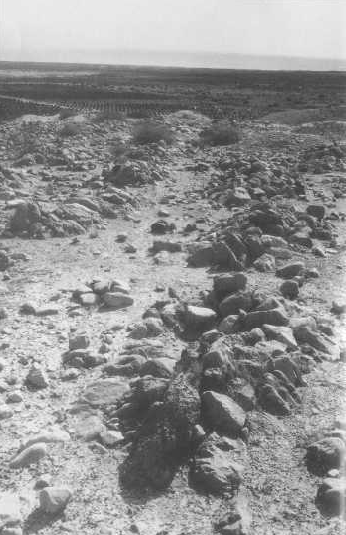
36 Several of the 1,200 or so rock-covered graves slightly to the
east of tb ruins.
Aligned north-south, contrary to normal Jewish practice, the graves
appear to be unique to the Qumran-type of community.
A small number
of graves has been opened, and the remains of men, women and
children found

37 A dozen or so Qumran-type graves - aligned north—south - have
been discovered
some nine miles south of Qumran, at En el-Ghuweir. Clearly there was
a settlement also on this site.
The caves in the Wadi and cliffs behind may well have served as
repositories
for the same type of scrolls as were found near Qumran.
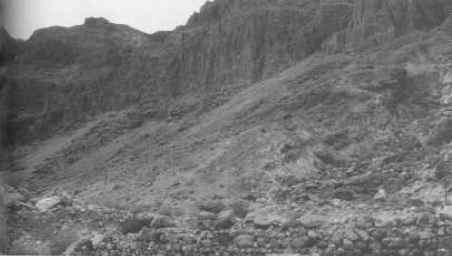
38 Ruins of a settlement at En el-Ghuweir near to the graves.
The ruins have been dated to the Herodian period.
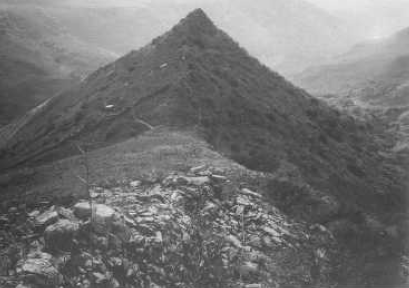
39 The pyramidal hill at Gamla in the Golan where the final citadel
stood.
Here, on 10 November 67 AD, 4,000 zealots died fighting the Romans
and another 5,000 killed themselves by jumping over the cliff.
The Dead Sea Scrolls provide an insight into the rationale which lay
behind the mass suicides.
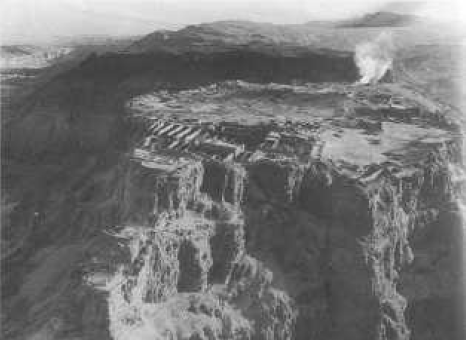
40 The ruins of Masada where, on 15 April 74 ad,
960 Zealots - men, women and children - killed themselves rather
than surrender to the Romans.
Thus the authors of the
Dead Sea Scrolls may be thought of as
'Essenes', but not in the sense as defined and described by
Josephus, Philo and Pliny. The accounts of the classical chroniclers
prove to be altogether too circumscribed.
They have also prevented
many modern scholars from making the necessary connections -
perhaps, in some cases, because it was not deemed desirable to do
so. If the connections are made, a different and broader picture
emerges - a picture in which such terms as 'Essene' and 'the Qumran
community' will prove to be interchangeable with others.
Eisenman
effectively summarizes the situation:
Unfortunately for the premises of modern scholarship, terms like:
Ebionim, Nozrim, Hassidim,
Zaddikim... turn out to be variations on the same theme. The
inability to relate to changeable
metaphor... has been a distinct failure in criticism.24
This, precisely, is what we are dealing with - changeable metaphors,
a variety of different designations used to denote the same people
or factions. Recognition of that point was urged as early as 1969 by
an acknowledged expert in the field, Professor Matthew Black of St
Andrews University, Scotland.
The term 'Essene' was acceptable,
Professor Black wrote:
provided we do not define Essenism too narrowly, for instance, by
equating it exclusively with the
Dead Sea group, but are prepared to understand the term as a general
description of this
widespread movement of anti-Jerusalem, anti-Pharisaic non-conformity
of the period. It is from
such an 'Essene-type' of Judaism that Christianity is descended.25
There is support for Professor Black's contention in the work of
Epiphanius, the early Christian writer who spoke of the 'Ossenes'.
Epiphanius states that the original 'Christians' in Judaea,
generally called 'Nazoreans' (as in the Acts of the Apostles), were
known as 'Jessaeans'.
These 'Christians', or 'Jessaeans', would have
conformed precisely to Professor Black's phraseology - a 'widespread
movement of anti-Jerusalem, anti-Pharisaic non-conformity'. But
there is an even more crucial connection.
Among the terms by which the Qumran community referred to themselves
was 'Keepers of the Covenant', which appears in the original Hebrew
as 'Nozrei ha-Brit’. From this term derives the word 'Nozrim’ one of
the earliest Hebrew designations for the sect subsequently known as
'Christians'.26 The modern Arabic word for Christians, 'Nasrani',
derives from the same source.
So, too, does the word 'Nazorean' or
'Nazarene', which, of course, was the name by which the 'early
Christians' referred to themselves in both the Gospels and the Acts
of the Apostles. Contrary to the assumptions of later tradition, it
has nothing whatever to do with Jesus' alleged upbringing in
Nazareth, which, the evidence (or lack of it) suggests, did not even
exist at the time.
Indeed, it seems to have been the very perplexity
of early commentators encountering the unfamiliar term 'Nazorean'
that led them to conclude Jesus' family came from Nazareth, which by
then had appeared on the map.
To sum up, then, the 'Essenes' who figure in classical texts, the
'Ossenes' mentioned by Epiphanius, and the 'Osi'm', the Qumran
community, are one and the same. So, too, are the 'Jessaeans', as
Epiphanius calls the 'early Christians'.
So, too, are the 'Nozrei
ha-Brit', the 'Nozrim', the 'Nasrani' and the 'Nazoreans'.
On the
basis of this etymology, it becomes clear that we are indeed dealing
with Professor Black's 'widespread movement', characterized, as
Eisenman says, by shifting metaphor, a variety of slightly different
designations used for the same people, shifting with time,
translation and transliteration, just as 'Caesar' evolves into
'Kaiser' and 'Tsar'.
It would thus seem that the Qumran community was equivalent to the
'early Church' based in Jerusalem - the 'Nazoreans' who followed
James, 'the Lord's brother'.27 Indeed, the 'Habakkuk Commentary'
states explicitly that Qumran's ruling body, the 'Council of the
Community', was actually located at the time in Jerusalem.28
And in
Acts 9:2, the members of the 'early Church' are specifically
referred to as 'followers of the Way' - a phrase identical with
Qumran usage.
Back
to Contents
|












